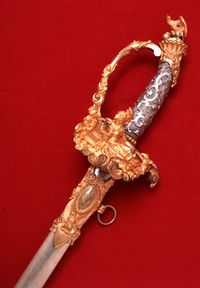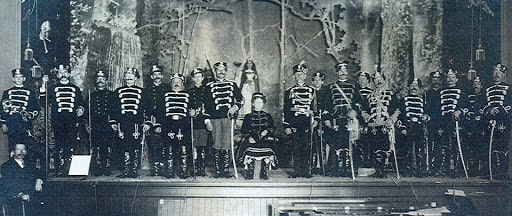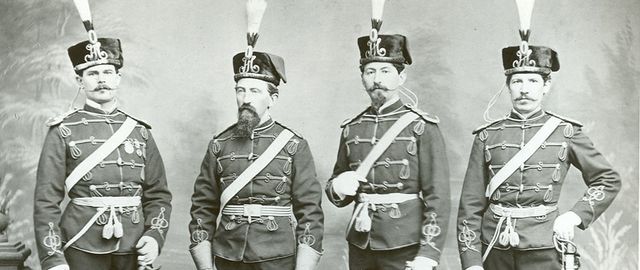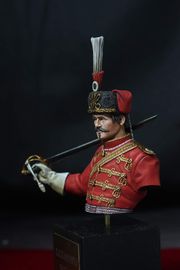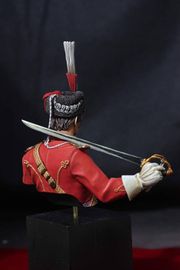Сакраментские гусары
Материал из ВикиВоины
Сакраментские гусары — кавалерийское формирование в составе Калифорнийского ополчения, существовашее с 1859 по 1906 гг.
История[править]
Even before California became a state, her citizens had formed several informal, volunteer military units. With admission to the Union this process was formalized in the State's 1849 Constitution. Even after legalization these units still maintained their informal flavor. By 1880, when almost all of the units had been incorporated into the state's National Guard, more than 400 had been organized. Some of the groups lasted a matter of weeks or months, Some the whole period. Some were organized around a common occupation, some a common ethnic background, and many were an extended group of friends. Almost all performed functions beyond purely military ones. A local unit, the Sacramento Hussars, was one of the longer lasting and more colorful of these. The following story is of a unique and successful adaptation by an ethnic group, to a potentially hostile environment
The Sacramento Hussars was the only cavalry unit in the county and was composed almost exclusively of native-born and ethnic Germans. Modeled after the light-horsed units in most European armies of the time, the Sacramento Hussars uniforms and equipment followed the same patterns. Their dark gray dolmans (short Hussar-style coats) and tight riding breeches were accented with white embroidery and clay-piped leather accouterments. The shortened dyed black fur busbies or colpacks (Hussar-style hats were topped with red and white ,brushes'. Originally, although not in the picture above, their high-topped riding pools were a gaudy yellow and red. These uniforms were expensive and in the four-year period between the unit formation (1859) and its incorporation into state service (1863) were paid by the individual members. The uniforms costed between $50 and $100, about the same price for the weapons and other equipage and a good horse, the group was known for the excellence of its horses, somewhat more.
These expenses alone would have limited membership in the unit to those relatively prosperous and a study of the muster roles confirmed this The incorporation into the state's militia forces on June 11, 1863 saw the first extent 'Bye' Laws and Constitution written and signed by the membership. This fascinating document, which is actually a book and contains a second set of By Laws and Constitution (1868) is in the possession of the California Center for Military History's archival collection. This book contains the minutes of many of the organization's meetings.
They met the first Wednesday evening of each month usually at their armory on the first floor of the City Library. A contemporary description of this"commodious arc well lighted" building arranged to indicate a well organized and efficient operation.
The Sacramento Hussars were organized 1859 as an independent cavalry company, composed entirely of German residents from the city of Sacramento. The company uniforms were procured in New York, at the cost of $50.00 each, and were designed after the Hussar Regiments of Prussian soldiers. Their uniforms included fur cap's adorned with a feather, a doublet, breeches to which the stockings were fastened, and red and yellow boots. Their arms consisted of a saber, a carbine and pistol.
The Hussars were especially noted for their efficiency in military tactics and maneuvers, as well as their splendid appearance in drill and parade. On January 9, 1860, the Hussars, with the Sutter Rifles and City Guard of Sacramento were in attendance at the gubernational inauguration of Milton S. Latham. The Hussars were especially noticeable for their fine horses, and showy trappings.[1] On March 3, 1860, the Hussars because of their extremely colorful appearance were called upon by civic leaders of Sacramento to form a mounted escort for the first Pony Express rider to reach Sacramento from Placerville.[2]
On June 11, 1863, the Hussars were mustered into the service of the State, as an unattached company of the Fourth Brigade. The company then received an allowance of $100 .00 a month from the State. In September of that year the company attended a ten day encampment at Camp Kibbe where they were under the command of Lieutenant Steudeman. The eighteen members of the company present made a brilliant spectacle in their dashing gray uniforms. Again in 1870 the full rank of Hussars appeared in parade at Oak Knoll on the west bank of the Sacramento River, about a mile north of Washington, Yolo County, for muster and inspection. The unit was again given distinction because of their exceptional qualifications in drill and discipline, and were considered an honor to the National Guard[3]
In 1874 the State Legislature appropriated the sum of $60,000 for the military fund for the twenty-fifth and twenty-sixth fiscal years. The Board of Military Auditors in order to stay within the appropriated amount reduced the allowance of each company to $35 .00 a month.[4] The Sacramento Hussars refused to stay in the State service under the new law. In consequence on July 10, 1874, the members voted unanimously to withdraw from the State Militia and tendered their resignation as company of the National Guard . The company was mustered out of service August 21, 1874. [5]
After being mustered out of the service of the State, the Hussars remained for many years an independent military organization. Their armory was located on the first floor of the City Library Building and was commodious and well lighted . Running through the center of the hall was a double saddle and bridle rack constructed after the most approved style . Each saddle tree was marked with a number corresponding with the number on the saddle. The saddles , bridles and all the trappings that went to make up a cavalry company were systematically arranged on pegs and hooks, and presented a sight that won the admiration of all who visited the armory . Aside from being an independent military company, the Hussars were also a benevolent organization, paying weekly benefits, caring for the sick and burying the dead . The initiation fee to become a member of the Hussars was $5 00 and the monthly dues $1.00 per month. The rules of the company were very stringent and fines were imposed and collected with military strictness . This company when they went on parade, as they did on all national holidays , was something that every Sacramentan felt proud of . They were a fine looking body of men, well disciplined, paid their own way and were under no obligation for State Aid. [6]
Оружие[править]
The elaborate gilt bronze hilt with seated Liberty holding a laurel and sword, representing the California state shield. Fluted pommel with eagle finial, clasping the world, indicating our nations might. Sliver plate grip with raised scroll design and American shield. Silver plate scabbard with gilt bronze bands, tip, and drag; The uppermost comprising draped flags with oval escutcheon, engraved, "Presented to / Capt. F. X. Ebner / by the Sacramento Hussars / April 26th 1872", atop a spread winged eagle and federal shield;
The middle band (not visible), a laurel wreath atop olive branches, indicating victory and honor through piece; The tip a single olive branch and drag with scrolled designed. The gilt etched, Damascus steel blade, with ornate silver overlay.
As reported on page 5 column 3 of the April 27, 1872 edition of the Sacramento Union:
PRESENTATION - The Sacramento Hussars, at their armory last evening at the conclusion of drill, presented to Captain Ebner a splendid saber and belt, recently purchased in New York at a cost of about $150, and as handsome as any in the State. The blade is very finely tempered and ornamented, the grips of Silver, the scabbard of steel, highly burnished, and the ornamental work of the scabbard and hilt gold-plated and of chaste design. A neat inscription shows that it was presented to Capt. Frank Ebner, by the Sacramento Hussars, April 26th. The presentation speech was made by Lieutenant Heilbron, who did justice to the occasion in expressing the high regard in which the Captain was held by his company. Captain Ebner made a feeling response, returning thanks in a manner, which his comrades plainly saw was heartfelt. The company subsequently visited Chas. Sellinger’s saloon, on Fifth Street, between J and K, where a collation had been spread, and there passed a pleasant hour of more in proposing, drinking and responding to toasts, etc.
As reported on page 3 column 3 of the April 27, 1872 edition of The Sacramento Daily Bee:
SWORD PRESENTATION. - Captain Ebner, the popular Chief of the Sacramento Hussars, was last night presented by the members of his company with an elegant sword and belt, just from New York, and which cost in the neighborhood of $150. Lieutenant Heilbron made the presentation speech, which the Captain happily responded to. A collation was afterward discussed at Charles Sellinger’s saloon.
Frank Ebner was a pioneering merchant in Sacramento engaged in numerous enterprises including the Sierra Nevada Hotel, the Ebner House (which still stands in old town Sacramento) and Ebner Brothers a wholesale liquor business which he established with his brother Charles, circa 1852. He reached the rank of Captain with the Sacramento Hussars, the only cavalry militia in the country, which established itself locally as a result of the Civil War in 1859. The Hussars were a flamboyant and disciplined group, visible on nearly every day of distinction, including escorting the first Pony Express rider to reach Sacramento in 1861, the gubernatorial inauguration of Milton S. Latham, and escorted the funeral procession of Oliver C. Jackson . They were outfitted at their own expense, which included a $150.00 uniform, procured in New York, along with arms, which comprised a saber, carbine, and pistols.
Mr. Ebner passed away, May 7, 1901 and as a testament to the reverence he was held throughout California the San Francisco Call carried the following obituary:
Captain F. X. Ebner. SACRAMENTO, May 7. - Captain F. X. Ebner, one of Northern California’s oldest wholesale liquor merchants, died suddenly this morning at his residence in this city. Death was due to apoplexy. He was a native of Germany, age 72 years.
Униформа[править]
Section One of the Seventh Article of California's first Constitution, enacted in 1850, stated, "The Legislature shall provide by law for organizing and disciplining the militia." In the next thirty years, this one sentence allowed Californians to form well over three hundred state sponsored local militia units. These units were as diverse as the new states' population. Usually formed either from men with a common ethnic or professional background, they were patterned after units of the United States Army, or on European models such as Zouaves, Jaegers, Lancers or Hussars.
The Sacramento Hussars were organized in 1859 as an independent cavalry company, composed entirely of residents of German.descent from the city of Sacramento [1]. Modeled after the light-horse armies in Europe their uniforms followed the same patterns and the Hussars were especially noticeable for their fine horses and showy trappings [2]. On March 3, 1860, because of their extremely colorful appearance, the Hussars were called upon to form a mounted escort for the first Pony Express rider to reach Sacramento [3]. Officered by a Captain, First Lieutenant, Second Lieutenant, and a Third Lieutenant the original strength was 26 men but that was soon raised to a maximum of 62 [4]. On June 11, 1863 the Hussars were mustered into the service of the State, as an unattached company of the 4th Brigade, California National Guard; remaining so until 1874 when they voted to again become an independent military company, as the state reduced the company's allowance from $100.00 to $35.00 per month [5]. The company was mustered out of the Guard August 21, 1874 [6].
The Plate shows the Hussars in the dress uniforms worn in the 1870's as they appear in one of the few photographs extant [7]. The officer on horseback is Captain August Heilbron, then Captain of the Hussars. The building is the Knickerbocker Engine Company #5 where the Hussars had their armory in 1877 [8]. Running down the sides of the hall was a double saddle and bridal rack constructed in the most approved style. The saddles, bridles and all the trappings that went to make up a cavalry company presented a sight that won the admiration of all who visited the armory [9]. The uniforms were procured in Germany from a dealer in New York at a cost of $150.00 each for enlisted and $400.00 for officers [10]. As officers uniforms were not allowed to be duplicated in Germany (unless the recipient was a German officer) all dolmans (tunics) were enlisted types. Officer uniform coats were red with gold braid and the trousers were dark gray worn tucked into the boots [11]. Each man provided his own horse and equipment which represented a considerable sum for those days [12]. The Pelisse (short outer jacket) was not worn. The Busby (hat) was of black dyed fur with red bag and the brushes red and white. When the company was formed, boots were red with yellow trim but were later replaced, as they wore out, with regulation yellow-piped black cavalry boots [13]. Rank insignia was as indicated by U.S. Army regulations prescribed for cavalry, the officers wearing the regulation shoulder knots of the 1870's as shown in the original photograph. The Sergeants rank is indicated by the disc on his collar and the narrow shoulder straps. Enlisted cartridge box, belts and straps were white leather [14]. Horse equipments were privately purchased from U.S. manufacturers as were sabertaches, sabers, officer dress belts and buckles.
After being mustered out of the service the Hussars remained for many years an independent military organization. Aside from being a military company the Hussars were also a benevolent organization, caring for the sick and burying the dead [15]. This company was always given the place of honor when they went on parade, as they did on all national holidays and state and city celebrations.
Галерея[править]
Сакраментский гусар, 1869 г. Планшет Шона Райана.


